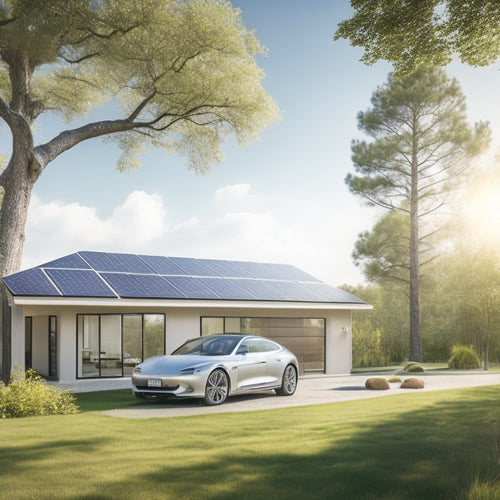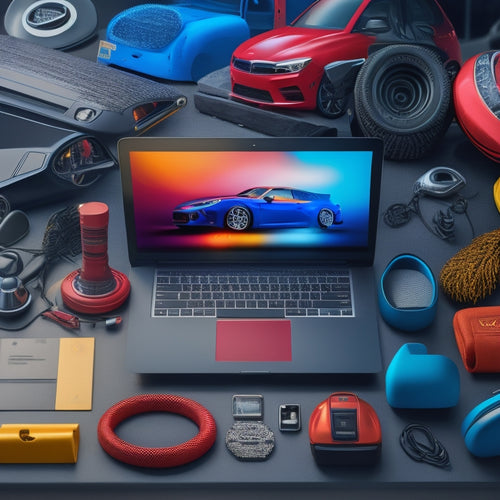
Build Your Own Solar Car Battery Power System
Share
You're about to start on a project that requires meticulous planning and attention to detail: constructing your own solar car battery power system. To get started, you'll need to choose the right solar panels, selecting for wattage, voltage, and compatibility. Next, pick a compatible battery type, considering factors like energy density, lifespan, and charging speed. Calculate your energy requirements, designing a safe charging system and assembling the solar array. Install a high-efficiency charge controller and monitor performance to guarantee peak output. As you navigate these complex steps, you'll uncover the secrets to a reliable and efficient system that meets your energy needs - and that's just the beginning of your solar-powered journey.
Key Takeaways
• Consider solar panel wattage, voltage, and compatibility when selecting panels for your system, aiming for high efficiency ratings (20-22%).
• Choose a deep cycle battery that suits your power requirements, considering factors like energy density, lifespan, and charging speed.
• Calculate your energy requirements by determining the power load of all electrical components and creating a load profile to identify peak usage periods.
• Ensure a safe and efficient charging system by regulating voltage and current, preventing overcharging and electrical shock risks.
• Install a high-efficiency charge controller and regularly inspect and clean electrical connections to maintain optimal system performance.
Choosing the Right Solar Panels
When selecting solar panels for your DIY solar car battery power system, you'll want to take into account the wattage, voltage, and compatibility of the panels to make sure they can efficiently charge your batteries.
Panel efficiency is vital, as it determines how much energy your panels can harness from the sun. Look for panels with high efficiency ratings (around 20-22%) to maximize your energy output.
Mounting options are also essential, as you'll need to secure your panels to your vehicle. You can choose from fixed mounts, adjustable mounts, or even portable solar panels with built-in stands.
Consider the space available on your vehicle's roof or hood, as well as the weight and durability of the panels. Don't forget to check the warranty and durability of the panels, as you'll want them to withstand the elements and last for years to come.
Selecting a Compatible Battery Type
As you build your solar car battery power system, you'll need to select a battery type that's compatible with your setup.
You'll have to contemplate the battery chemistry options, such as lithium-ion, lead-acid, or nickel-cadmium, each with its own strengths and weaknesses.
Battery Chemistry Options
You'll need to choose a battery chemistry that's compatible with your solar car's electrical architecture, considering factors like energy density, lifespan, and charging speed.
Lithium-ion batteries are a popular choice, and for good reason - they offer high energy density, long lifespan, and rapid charging capabilities.
But, let's not count out Lead-Acid batteries just yet! They may not be as flashy, but they're tried-and-true, affordable, and still a reliable option. Lead-Acid batteries have come a long way, and some modern variations, like Enhanced Flooded Batteries, offer improved performance.
If you're looking for a more eco-friendly option, consider Nickel-Metal Hydride (NiMH) or Nickel-Cadmium (NiCd) batteries. They're less toxic than Lead-Acid and still pack a punch.
However, Lithium advantages can't be ignored - they're lightweight, efficient, and perfect for high-performance solar cars. But, if you're on a budget, Lead alternatives like Calcium-Alloy or Maintenance-Free batteries might be the way to go.
Ultimately, it's all about finding the perfect chemistry for your solar car's unique needs.
Deep Cycle Requirements
To guarantee your solar car's battery power system operates efficiently, you need a deep cycle battery that can handle the frequent charge and discharge cycles, making a compatible battery type selection essential. You don't want your battery to die on you in the middle of a road trip, do you?
When choosing a deep cycle battery, consider the cycling limits and battery durability. A battery with a higher cycle life will last longer and provide more power over its lifespan. Here's a breakdown of some popular deep cycle battery types:
| Battery Type | Cycle Life | Depth of Discharge (DOD) |
|---|---|---|
| Flooded Lead-Acid | 200-500 cycles | 50% DOD |
| AGM (Absorbed Glass Mat) | 500-1000 cycles | 80% DOD |
| Lithium-Ion | 1000-2000 cycles | 90% DOD |
As you can see, Lithium-Ion batteries have the highest cycle life and DOD, making them an excellent choice for solar car battery power systems. However, they're also the most expensive option. Consider your budget and power requirements when selecting a deep cycle battery. Remember, a good battery is the backbone of a reliable solar car battery power system.
Calculating Your Energy Requirements
As you design your solar car battery power system, you'll need to calculate your energy requirements to make sure you're generating and storing enough power to meet your needs.
To do this, you'll need to determine your power load needs, assess your energy storage needs, and calculate the size of your solar panel array.
Determining Power Load Needs
Calculate your energy requirements by tallying up the total power load of all components that'll be running off your solar car battery power system. This is important to make sure your system can handle the energy demands of your car's electrical components. Think of it as an energy audit - you're evaluating how much power each component needs to function properly.
Here are some key components to think about:
-
Headlights and interior lights: How many lights do you have, and what's their wattage?
-
Radio and entertainment system: What's the power draw of your stereo and other accessories?
-
Ventilation and cooling system: What's the energy requirement of your car's fans and air conditioning?
-
Safety features: Do you have features like alarm systems or backup cameras that require power?
-
Charging ports and accessories: How many devices will you be charging on the go?
Assessing Energy Storage Needs
Now that you've tallied up the total power load of your car's electrical components, it's time to figure out how much energy storage you need to keep them running smoothly. You've got the total load, but you need to determine how long you want to run those components on stored energy.
This is where energy efficiency comes in – you want to maximize it to get the most out of your battery power system. Think of it like this: the more critical your system, the less energy storage you'll need.
To calculate your energy requirements, you'll need to create a load profile, which is essentially a chart of your car's energy usage over time. This will help you identify peak usage periods and optimize your energy storage accordingly. Load profiling is important, as it makes sure you've got enough juice to power your car's electrical components when you need it most.
By accurately evaluating your energy storage needs, you'll be able to design a solar car battery power system that's tailored to your specific requirements, ensuring you're always on the road to energy independence.
Calculating Solar Panel Size
You've determined your energy storage needs, and it's time to size up your solar panel array to meet those requirements, ensuring you can harness enough sunlight to keep your car's electrical components running smoothly.
To calculate the ideal solar panel size, you'll need to take into account your energy requirements, the efficiency of your solar panels, and the amount of sunlight your car will receive.
Here are some key factors to take into consideration when calculating your solar panel size:
-
Peak sun hours: How many hours of direct sunlight will your car receive per day?
-
Efficiency metrics: What's the efficiency rating of your solar panels, and how will that impact energy production?
-
Angle optimization: At what angle should you install your solar panels to maximize energy production?
-
Shading considerations: Will any parts of your car or surrounding environment cast shadows on your solar panels?
-
Energy buffer: How much extra energy storage do you need to account for cloudy days or unexpected energy spikes?
Designing a Safe Charging System
Your charging system's safety hinges on the precise regulation of voltage and current, guaranteeing that your solar car battery is protected from overcharging and electrical shock. Think of it as a delicate dance between your solar panels, battery, and charging controller.
One misstep, and you'll be dealing with a fried system or, worse, a safety hazard.
When it comes to fusing options, you've got a few choices. You can opt for a DC-rated fuse or a circuit breaker, both of which will safeguard your system from those pesky electrical surges. For added peace of mind, consider installing a battery management system (BMS) to monitor and regulate your battery's state of charge.
Grounding methods are equally essential. A solid grounding system will make certain that your system is protected from electrical shock and stray currents. You can choose between a grounding rod or a grounding plate, both of which will keep your system safe and humming along.
Assembling the Solar Array
With a safe and efficient charging system in place, it's time to turn your attention to the heart of your solar car battery power system: the solar array, where you'll carefully select and assemble the photovoltaic modules that will convert sunlight into electrical energy.
As you assemble your solar array, keep the following essential considerations in mind:
-
Array orientation: Make sure your solar panels are angled for maximum energy absorption, taking into account your vehicle's roof shape and sun movement patterns.
-
Cable management: Organize cables neatly to reduce shading, improve airflow, and prevent damage from debris or vibration.
-
Mounting options: Choose a secure and adjustable mounting system that accommodates your vehicle's unique contours and allows for easy panel cleaning.
-
Panel cleaning: Develop a routine for regular cleaning to maintain top energy output and prevent dirt buildup.
-
Wiring strategies: Design a wiring layout that minimizes voltage drop, reduces heat buildup, and ensures safe, efficient energy transmission.
Installing the Charge Controller
Now that your solar array is assembled and ready to harness the sun's energy, it's important to install a high-efficiency charge controller that guarantees your battery is safely and efficiently charged. This key component ensures your solar car battery power system runs smoothly and prolongs the lifespan of your battery. When selecting a charge controller, consider the maximum power point tracking (MPPT) technology, which optimizes energy harvesting.
For a seamless installation, consider mounting options that provide easy access for maintenance and upgrades. You can either surface-mount the controller or recess-mount it, depending on your system's design and available space. Make sure the controller is securely fastened to prevent vibrations and shocks.
Wiring considerations are critical to prevent electrical hazards and energy losses. Use appropriate gauge wires that can handle the system's maximum current, and keep the wiring as short as possible to minimize voltage drops. Properly label and organize the wires to facilitate troubleshooting and future modifications.
Monitoring and Maintaining Performance
To guarantee peak system performance and extend the lifespan of your solar car battery power system, regular monitoring and maintenance are essential. You've invested time and effort into building your system, and now it's time to make sure it's running smoothly.
Performance tracking is critical to identify areas that need improvement, and system optimization is key to maximizing your energy harvest.
Here are some essential tasks to add to your maintenance routine:
-
Check battery voltage and state of charge regularly: This will help you identify any issues with charging or discharging.
-
Monitor solar panel performance: Keep an eye on energy output to ensure your panels are performing at their best.
-
Inspect electrical connections: Clean and tighten connections to prevent corrosion and ensure efficient energy transfer.
-
Update your charge controller's firmware: Stay up-to-date with the latest features and performance enhancements.
-
Perform routine cleaning and inspection: Keep your system free from debris and dust to maintain peak performance.
Frequently Asked Questions
Can I Use a Deep Cycle Battery for My Solar Car Battery System?
'Yep, you can use a deep cycle battery, but remember to prioritize battery maintenance to extend its cycle life - and don't forget to properly size your battery for peak performance, or you'll be stuck in neutral!'
Will a Higher Voltage Solar Panel Increase My Charging Speed?
'Hey, you're wondering if a higher voltage solar panel will supercharge your ride, right? Well, here's the deal: a higher voltage won't necessarily boost charging speed, thanks to voltage limitations and the pursuit of peak charge efficiency, buddy!'
Can I Charge My Battery With a Wind Turbine as Well?
"You're thinking outside the box, and we love it! Yes, you can charge your battery with a wind turbine, harnessing renewable energy and reducing your carbon footprint. It's a clever combo of wind and solar power!"
How Do I Ensure My System Is Compliant With Local Building Codes?
'You'll need to navigate permit requirements and code enforcement for your system; research local ordinances, obtain necessary permits, and guarantee compliance to avoid costly reworks - don't get zapped by unexpected fees!'
Can I Upgrade My System in the Future if My Energy Needs Change?
"As your energy demands evolve, rest assured you can upgrade your system; its flexibility allows for seamless modifications, so you can adapt to changing needs without breaking the bank – or the environment!"
Related Posts
-

Why Invest in Solar Car Battery Chargers Online?
By investing in a solar car battery charger online, you're not only reducing your reliance on fossil fuels but also o...
-

Top 10 Tips for Buying Car Accessories Online
When purchasing car accessories online, you should take proactive steps to avoid low-quality or incompatible products...
-

Step-by-Step Guide to Converting Your Vehicle to EV
You'll begin by evaluating your vehicle's conversion potential, analyzing its weight, aerodynamics, and powertrain co...


